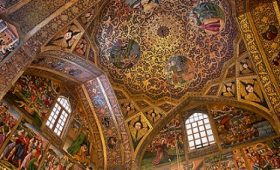Takhte Foulad Cemetery: A Historic and Spiritual Landmark in Isfahan
Isfahan, known for its rich history, vibrant culture, and architectural treasures, stands as one of the most celebrated cities in Iran. Famous for its historical monuments, the Zayandeh River, and unique handicrafts, Isfahan has long been a top destination for travelers seeking a blend of ancient history and modern cultural heritage. Among its many remarkable sites, the Takhte Foulad Cemetery stands out as an essential spiritual and historical landmark. Located in the heart of the city, this ancient burial ground is not only one of the oldest cemeteries in Isfahan but also serves as a symbol of the city’s multicultural and multi-religious legacy.
Historical Significance of Takhte Foulad Cemetery
The Takhte Foulad Cemetery is an important site that dates back to pre-Islamic Iran. Its name, which translates to “The Carpet of Steel,” is believed to be a reference to the location’s significance and historical importance. Over the centuries, the cemetery has been the final resting place for a wide range of individuals, including royalty, scholars, religious leaders, and artists. The cemetery’s long history, spanning several centuries, makes it a symbol of Isfahan’s deep cultural roots.
Historically, Takhte Foulad was considered one of the major burial grounds of Isfahan, with people from different walks of life buried here. The cemetery continued to serve as a burial site throughout various dynasties and has retained its significance, reflecting the evolution of Isfahan as both a political and religious center in Iran.
A Burial Site for Religious and Cultural Figures
The Takhte Foulad Cemetery is known for housing the graves of prominent historical figures from various religious backgrounds, showcasing the city’s religious diversity. The cemetery contains the tombs of Shia Muslim scholars, Sufi mystics, Armenian bishops, and even Jewish religious leaders, symbolizing the peaceful coexistence of multiple faiths in Isfahan.
Many notable figures from the Safavid period, which marked a golden age in Isfahan’s history, are buried in Takhte Foulad, reflecting the city’s flourishing cultural and spiritual life during that era. In particular, the tombs of famous Islamic scholars and saints have made the cemetery an important site for pilgrims from across the country. Visitors to Takhte Foulad often come to pay their respects and reflect on the historical figures who have contributed to the spiritual and cultural development of Isfahan.
The Architectural Design and Layout
The layout of the Takhte Foulad Cemetery is a reflection of the traditional Islamic architectural principles, with narrow, winding pathways leading visitors through the tombs and shrines of the departed. Tombs and mausoleums are scattered throughout the cemetery, each uniquely designed according to the status and identity of the individual buried there. Some tombs are simple and modest, while others are more elaborate, with inscriptions, tilework, and engraved details marking their importance.
The mausoleums of the prominent figures, particularly those of the Shia scholars and Sufi saints, are more ornate, showcasing traditional Persian architecture and Islamic art. Many tombs are built with stone, brick, and ceramic tiles, some decorated with intricate calligraphy and geometric patterns. This diversity in the tombs’ designs not only reflects the city’s religious heritage but also highlights the artistic traditions of Isfahan through the ages.
The cemetery’s landscape design is also notable for its peaceful atmosphere, with several trees and shrubs lining the pathways, creating a serene and reflective environment for visitors. It is a place where visitors can not only pay their respects but also experience the tranquil beauty of Isfahan’s historic landscape.
Cultural and Spiritual Importance
Takhte Foulad Cemetery is not just a burial ground; it is a site of great spiritual and cultural significance for the people of Isfahan. The cemetery holds a central place in the religious life of the city, with numerous pilgrimages taking place to the graves of saints and scholars. Shia Muslims, Sufi practitioners, and other religious communities regularly visit the site to pray, reflect, and seek blessings from the prominent figures buried there.
Beyond its spiritual significance, the cemetery is also a site where the city’s cultural diversity is expressed. The presence of tombs from different religious communities, including Armenians, Jews, and Zoroastrians, symbolizes Isfahan’s role as a crossroads of different cultures and faiths throughout history. The coexistence of these various communities is one of the hallmarks of Isfahan’s multicultural heritage, which is a significant aspect of the city’s identity even today.
Visiting Takhte Foulad Cemetery
Takhte Foulad Cemetery, despite its historical importance, remains relatively peaceful and serene, offering visitors an opportunity to connect with Isfahan’s rich past. It is open year-round and continues to attract both local residents and tourists interested in learning about the spiritual and cultural legacy of Isfahan.
The cemetery is especially important during religious events and pilgrimages, when the tombs of notable figures are visited by thousands of pilgrims and visitors who come to seek spiritual guidance or simply reflect on the historical significance of these figures. While visiting, tourists can take a walk through the cemetery’s pathways, reflect on the rich history that the site represents, and explore the architecture and art that define Isfahan’s Islamic and Persian cultural traditions.
The Takhte Foulad Cemetery is a remarkable landmark in Isfahan, offering a blend of history, culture, and spirituality. Serving as the final resting place for some of Isfahan’s most influential historical and religious figures, the cemetery provides a glimpse into the city’s multicultural past and spiritual significance. The architecture, landscaping, and religious importance of the site make it a must-visit for those seeking to understand the deep-rooted cultural heritage of Isfahan.
Whether you are interested in history, architecture, or spirituality, Takhte Foulad Cemetery offers a profound and reflective experience. As a spiritual sanctuary and historical monument, it continues to honor the memory of those who contributed to the cultural legacy of Isfahan and remains a vital part of the city’s identity for generations to come.


